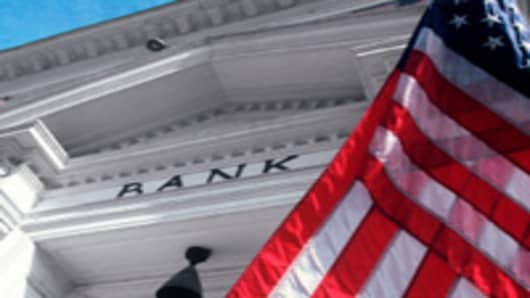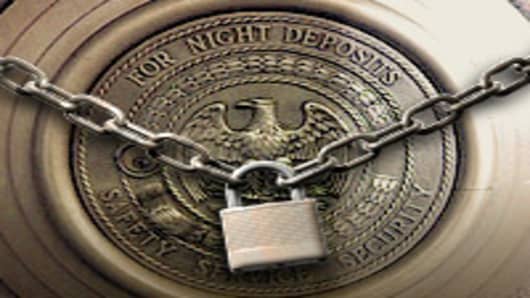Banks are the great poison of the stock market these days—not because of what is known about them, but rather what is unknown.
Looming specters surround the industry at every turn — contagion from European debt crisis, a fiscal mess in Washington and a little-noticed ballooning in the opaque derivative markets. All this has investors running scared from a group that otherwise might be quite appealing.
Before Wednesday's market rally, financial stocks were down 25 percent for the year on the Standard & Poor's 500 Index, which itself was off 5 percent for the year.
Even Wednesday's rally underscores just how deeply the concerns run.
Markets surged on a move by global central banks to provide cheaper dollar loansto European banks exposed to the euro zone's sovereign debt crisis. The aggressive intervention, which harkened back to the moves after Lehman Brothers collapsed and sparked a global credit crisis, pushed major indices up more than 3 percent and banks higher by nearly 5 percent.
But once the euphoria ends, banks still will have plenty of issues to confront.
"Based on a crushing bear market in bank stocks, investors are understandably jaded and very skeptical as it relates to the relative performance of bank stocks," said John Pandtle, portfolio manager at Eagle Asset Management. "It reflects a very significant risk premium or discount rate based on the macro uncertainty and all the concern that you see related to Europe."
Standard & Poor's helped pull the curtain back somewhat on Tuesday when it downgraded most of the big U.S. banks. In part, itwas a natural move considering S&P downgraded the debt rating of the US government in August.
Even some of banking's biggest supporters — Dick Bove of Rochdale Securities, to name one — said the downgrade was justified considering bank debt had been selling below even the new rankings.
But the problems run deeper than difficulty on the debt markets.
Investor perception, for good or bad, is that if Europe's big banks start to failwhen the expected sovereign debt restructuring/defaults begin in earnest, U.S. banks, particularly the largest institutions, won't be able to get out of the way. (Bove takes notable exception to this premise, insisting that American banks actually will benefit from a European financial crisis.)
One big number that signifies other possible dangers: $708 trillion.
That is the total notional level of outstanding over-the-counter derivatives as of the first half of 2011, according to the Bank for International Settlements. Derivatives are those black-box financial instruments that helped bring down the U.S. financial system after the subprime mortgage industry exploded in the previous decade.
Of course, the notional value only represents a theoretical level of exposure should every derivative contract out there come to full payment.
The gross market value — a closer, though still inexact, computation of actual exposure — is at $19.5 trillion.
Because the derivatives market has such little visibility, it's difficult to determine what the exact exposure would be to American banks should derivative contracts tied to European debt explode. But a few of the BIS numbers tell a disturbing story about risk acceleration.
The notional level represents an 18 percent gain in derivative exposure from the second half of 2010, while the gross market value dropped by 8 percent, a directional move indicative of falling value in the contracts.
Interest rate derivatives surged by 19 percent, while forex derivatives increased by 12 percent.
So at a time when tightened regulations were designed to cut risk to the global financial system, the amount of hard-to-decipher high-risk trading actually accelerated in the first half of the year, the most recent period covered by BIS data.
"There's no doubt that exposure remains very significant," said Fred Cannon, director of research and chief equity strategist at Keefe, Bruyette & Woods. "The one concern one has to have is that counterparty risk, to the extent that they're trading with European counterparties. One of the things we learned in the financial crisis is the fire usually isn't where the fire hose is pointed."
Significantly, Cannon pointed out that the bulk of the derivative exposure is nestled within the industry's largest names — Goldman Sachs , Morgan Stanley , JPMorgan Chase , Citigroup and Bank of America — the supposed too-big-to-fail names that have only gotten larger since the financial crisis.
On the bright side of things, banks have reduced the disparity on their balance sheets between assets and total cash, or what analysts commonly refer to as "leverage."
At the peak of the financial crisis, the balance sheets of global banks were levered at about 37 to 1. The consequence of that was that when loans, particularly mortgages — counted as assets — started going bad, the banks didn't have enough cash on hand to take the hit.
The trouble was particularly acute for insurers such as American International Group , which sold credit default swaps to investors who bet against the subprime market. AIG didn't have enough money to pay off once mortgage defaults exploded, and subsequently required a government bailout.
Now, banks are near record-lows for leverageat 7 to 1, according to computations by economists at Deutsche Bank.
Even that metric, though, contains a warning sign.
A Desire to Lend, But No Takers
Banks reduced their leverage largely by halting loans and hoarding cash after the crisis. Total bank assets peaked at $12.2 trillion in October 2008 — shortly after the fall of Lehman — and have been flat around $10.8 trillion, according to Deutsche Bank. Most of that decline came from a $1.2 trillion drop in loan activity.
The reason why banks stopped lending primarily was to comply with regulatory requirements, which have provided an economic Catch-22 that also has fueled investor concern.
In response to the years of irresponsible lending that precipitated the financial crisis, regulators have demanded that banks only loan to high-quality customers. But it is those individuals and businesses with good cash positions and credit histories who don't want to borrow in a down economy. Conversely, those who want and need the loans can't get them.
As indicated in the most recent Federal Reserve Senior Loan Officers survey, banks have relaxed lending standards and indicated a desire to lend, but have found too few takers.
"The challenge there is the borrowers who are in very good condition are sitting on a boatload of cash. So they're not all that anxious to borrow and the weak borrowers are still constrained because of recent credit history," Cannon said. "The thing that would get lending going would be a revival in the animal spirits of those in strong financial shape."
The window for getting those spirits going, though, could be a short one.
"It is encouraging that in response to the increasingly uncertain economic outlook banks have continued to loosen their lending criteria," Paul Dales, senior US economist at Capital Economics in Toronto, said in a recent report. "But it is a bit disturbing that firms have become less eager to borrow. This could take some of the gloss off business investment, which has been a rare shining light in an otherwise gloomy economic recovery."
And then there's Europe. Should the central bank solution applied Wednesdayprove to be fleeting, the increased appetite for risky lending among banks could be brief.
"The real danger, however, is that the events in Europe trigger a sharp fall in the willingness of lenders to lend," Dales said. "Another credit crunch is a risk that will hang over the U.S. economy until the problems in Europe are resolved once and for all."
Finally, there's the Fed .
The U.S. central bank has set criteria for stress tests in 2012 that assume devastating conditions: A 52 percent drop in stocks, a 21 percent slump in already-depressed housing prices, and a stunning upturn in unemployment to 13 percent.
Overkill? Perhaps. But the standards reflect the Fed's desire to make sure banks can withstand a major global crisis.
"The decline in bank stock prices and the financial crisis unfolding in Europe has the Fed concerned over contagion and risk to the U.S. banking system. High levels of retained capital at U.S. banks are a defense against this concern," KBW's Cannon said in a research note.
"European stress tests have done little to stabilize the market for European bank stocks," he added. "We believe the Fed wants to ensure that the U.S. stress test is more credible than what is presented in Europe."
Bove is more pointed in his views on the stress test plan.
"If the banking system is required to develop plans to meet the most adverse of these scenarios," he wrote in a series of notes lambasting the Fed, "it will be unable to function to assist the economy and a recession could result."
Yet Bove has been a continuous advocate for banks, insisting, for instance, that S&P's only mistake in its Tuesday downgrade was not noting that bank performance is improving.
Investors, though, aren't having any of it.
Cannon says investors are wise to stay away from large institutions, while Pandtle, of Eagle Asset Management, said there is only selected value in the space.
"We think there is compelling value in a select group of bank stocks," Pandtle said. "But to make a macro call on the banks that you have to own these stocks now — it's too early to make that call until you have more visibility."







